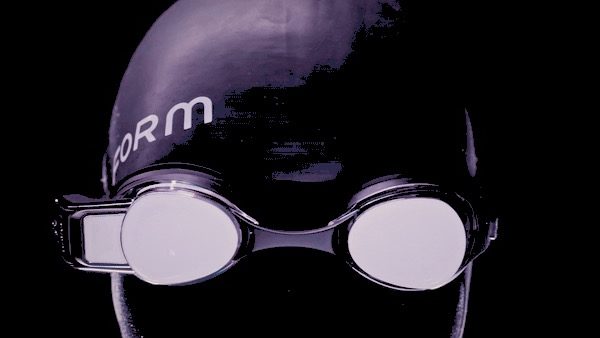Augmented reality apps have already begun taking over the sports fan experience – Bundesliga’s real-time AR stats app, Gatorade’s Dr. Seuss-meets-soccer Snapchat portal, the Cavaliers turned their scoreboard into an AR game, and the Soccer on Your Tabletop experience are just a few. This is to be expected, given that AR is a clear fit for entertainment. However, it’s the use of AR among players which will have the true impact.
Smart glasses, 3D projectors, and AR apps are all contributing to this new form of AR coaching. And you don’t need to be a pro athlete to receive these insights.
AR for Solo Sports
Augmented reality is particularly well-suited for solo-sports, mostly because it’s just you against the clock or the course. There’s no contact, no teammates to worry about, and no objects flying at you. This means fewer variables to analyze and an easier time bringing AR into the equation.
Swimmers just received one of the coolest, most practical applications of AR. The Form Swim Goggles are smart AR swim goggles that display swimming metrics such as split times, stroke count, and distance in the goggles. Essentially it’s a swimming wearable that makes technique adjustments during a swim and also tracks your swims over time to see how you’re improving. At $200, I could see mid to high-level recreational swimmers and triathletes using these.
Golfers are right behind swimmers. PuttView is an AR platform that scans a putting green and provides visual feedback on all important parameters of the putt you have ahead of you – including the read, line, and speed. In theory, it’ll help you make the perfect putt. Similarly, Nike patented a smart glasses version of this that would analyze your shot and track your golf ball. I don’t think we’re too far away from a system like this helping with all shots on a course. The low-hanging fruit would be implementing the Flag-Finder tech into a pair of sunglasses.
Other solo sports that could probably benefit from AR training applications would be: bowling, tennis, track-and-field, climbing, archery, and maybe even surfing.
However, this doesn’t exclude team sports altogether.
AR for Team Sports
Before AR comes onto the team sports court, it will start by assisting with training.
On the football practice field, players are putting on a new type of helmet called the GoRout which features a visor that has AR capabilities. The heads-up-display in this helmet will show players the routes they need to run and what their assignments are on a given play. The future of this could be very expansive, even though I don’t see this tech making it on the real field anytime soon. Rather, the NFL’s partnership with Amazon to create NextGen Stats is something to look at.
Basketball players everywhere are using HomeCourt, an iPhone app that uses AR to detect a hoop and basketball, measuring kinematics, trajectory, release times, and the number of shots made. The NBA – along with Mark Cuban, Steve Nash, Al Horford, and dozens of other high-profile ballers – have invested in HomeCourt with the goal of making it a recruitment app that can find and develop the next stars.
A company called DribbleUp is taking a more systematic approach by creating AR-enabled balls for a variety of sports – including basketball, soccer, and volleyball. The AR sports balls are scanned and tracked by an app that gives players drills to do. The app can track a player’s drills and give them feedback, helping them improve over time.
The Rise of Intelligent Coaching
There are a seemingly incalculable number of motions occurring in sports at any given time. This is why finding a way to isolate the movements and provide actionable feedback is worth so much to athletes – whether for recreational or competitive purposes.
In July of 2017, I talked about how an AI running coach implanted in my headphones helped me run my fastest mile ever. At the core of this impressive technology was loads of running data and a nifty high-tech concept called gait analysis – which is “nerd” for helping you optimize your strides.
Shortly thereafter I envisioned the application of digital, medical tattoos for the purposes of tracking player vitals in-game – providing a way for teams to optimize the energy and performance of their athletes during a game.
Take the biological tracking of digital tattoos, combined with the insights of AI coaches, and layer on the AR interfaces from above and we’ll reach a new age of Intelligent Coaching.
It’s a revolution we’re going to see in sports science.
Even though we’ve had the ability to monitor motion for some time, it’s mostly been limited to quantity (i.e. number of steps, stairs, time splits, percentages).
The revolution in AR and intelligent coaching brings the ability to monitor not just the quantity of motion, but also the quality. This is the real gold mine for athletic improvement.
